Fancy charging up your electric car in 10 minutes?
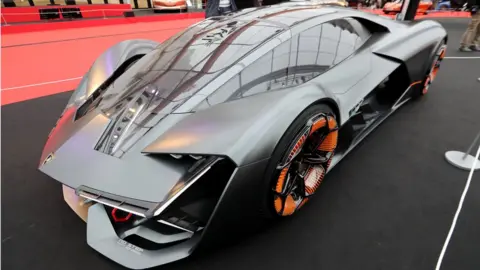 AFP/Getty Images
AFP/Getty ImagesImagine being able to charge your electric car in minutes rather than hours, or your smartphone in seconds.
That's the enticing prospect being touted by researchers who reckon they've discovered a new material that could boost the performance of a carbon-based supercapacitor - sometimes called an ultracapacitor - a type of energy storage device that can be charged very quickly and offload its power very quickly, too.
Dr Donald Highgate, director of research at Superdielectrics Ltd, says a material he originally developed for soft contact lenses is also surprisingly good at holding an electrostatic field.
Very simply, supercapacitors don't produce electricity through chemical reactions as conventional batteries do, they create these electrostatic fields.
Dr Highgate is working with Bristol and Surrey universities to develop supercapacitors using the new polymer and hopes that they could eventually rival, or even surpass, lithium-ion (li-ion) batteries - so long as they manage to replicate prototype performance on a large scale.
So far, supercapacitors have been good at providing quick bursts of power - to start a car engine, for example, or to give trains a boost when accelerating. They're also well-suited to harvesting energy from vehicles when they brake, making them an important component in electric vehicles.
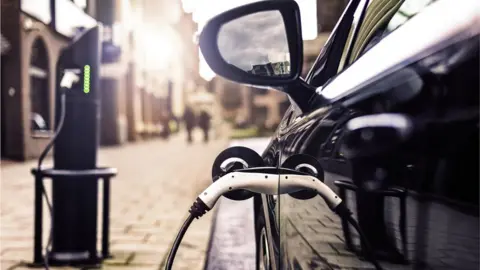 Getty Images
Getty ImagesAnd national electricity grids use them to provide quick power top-ups when balancing supply and demand.
South Korea's capital Seoul is hoping to have 3,500 supercapacitor-powered buses operating by 2020, and they're also being used in Shanghai, China. European car maker PSA Peugeot Citroen has been using them in its cars since 2010 - supercapacitor maker Maxwell Technologies says more than a million vehicles now incorporate its products.
But to date, supercapacitors haven't been very good at holding much energy or holding on to that energy for very long.
This poor energy density, as it's called, the amount of energy they can hold per kilogramme, has put them at a significant disadvantage to li-ion batteries.
More Technology of Business
 Getty Images
Getty Images"The two main advantages of conventional supercapacitors over batteries are their ability to handle much higher charge and discharge rates, and their longer cycle life," says Gareth Hinds, Fellow of the UK's National Physical Laboratory.
"The downside is that they tend to be relatively high cost and can only store a few seconds-, or at most, minutes-worth of energy."
This isn't a problem when your supercapacitor is being used to power a tool on a factory assembly line, for example. It can be recharged in seconds once it's placed back in its charging dock.
But it is if you're in an electric car or bus that needs recharging every few miles.
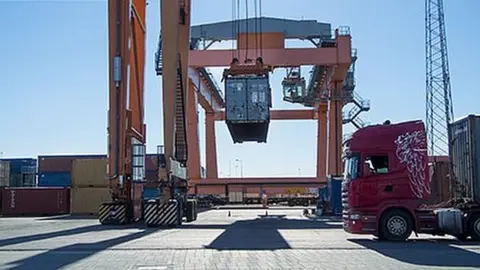 Skeleton Technologies
Skeleton TechnologiesTaavi Madiberk, chief executive and co-founder of Skeleton Technologies, a supercapacitor maker based in Estonia, Germany and Finland, says his products incorporate layers of graphene - a single layer of carbon atoms arranged in a hexagonal lattice - and other carbon-based materials in its supercapacitors.
These layers have a huge surface area - just 1g of graphene can cover 2,000 sq m, says Mr Madiberk. This allows them to hold on to a lot more energy.
His firm's products are already used in hybrid vehicles, particularly buses and lorries. In one experiment, they installed supercapacitors in a Sainsbury's supermarket diesel-electric delivery van and "achieved 32% fuel savings", says Mr Madiberk.
But he acknowledges that in the short-term, combining supercapacitors with li-ion batteries is probably the best way to enjoy the best of both worlds, particularly in electric vehicles.
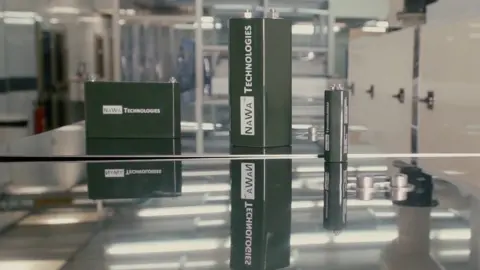 NaWa Technologies
NaWa Technologies Ulrik Grape, chief executive of NaWa technologies, another supercapacitor maker based in the South of France, agrees, saying: "Supercapacitors don't store as much energy but their response is instantaneous. So a supercapacitor could handle acceleration and energy recovery under braking - taking care of the stressful part of a battery's life - possibly doubling or tripling a battery's life expectancy."
NaWa's technology involves electrodes made from "vertically aligned carbon and graphene nanotubes that can store the energy on the surface of these tubes," explains Mr Grape.
These tubes, which are coated with another carbon-based material, are so tiny you can fit 10 billion of them in a square centimetre.
As carbon is a light material, incorporating supercapacitors into li-ion batteries would also reduce the overall weight, and this would improve the range performance of an electric vehicle.
A Formula E racing car's battery, currently made by Williams Advanced Engineering, weighs 300kg, but this could be reduced by a third to 200kg, NaWa believes, without any loss of range.
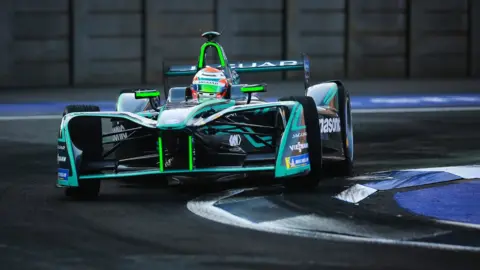 ALL SPORT/Getty Images
ALL SPORT/Getty Images"We think the ability to charge and discharge a battery fast will be one of the most important things in the future," says Mr Grape.
"We don't have as much energy as a lithium-ion battery but we can do many more cycles - charges and discharges - up to a million. Carbon is such a robust material."
By contrast, a normal battery, which relies on chemical reactions to create energy, eventually wears out once those chemicals lose their potency - after about 3,000 to 5,000 cycles of charging and discharging.
Another advantage of supercapacitors, makers say, is that they don't require rare materials, such as cobalt.
Of course, supercapacitors don't mean the end of traditional batteries by any means. Li-ion technology is still being improved by about 5-10% each year.
New forms of energy storage will be critical to the success of renewable energy as a replacement for fossil fuels. When the sun doesn't shine or the wind doesn't blow, we'll need to access stored energy very quickly to plug the gap.
As well as traditional energy storage methods, such as pumped hydro, flywheels, compressed gas and large battery arrays, highly efficient supercapacitors could eventually become a crucial component in a fully sustainable energy network.
But these are early days.
"Polymer-based supercapacitors are emerging as a promising technology," concludes Gareth Hinds, "but there is a lot of work still to do to achieve the required energy storage capacity without compromising on power, lifetime and cost."
